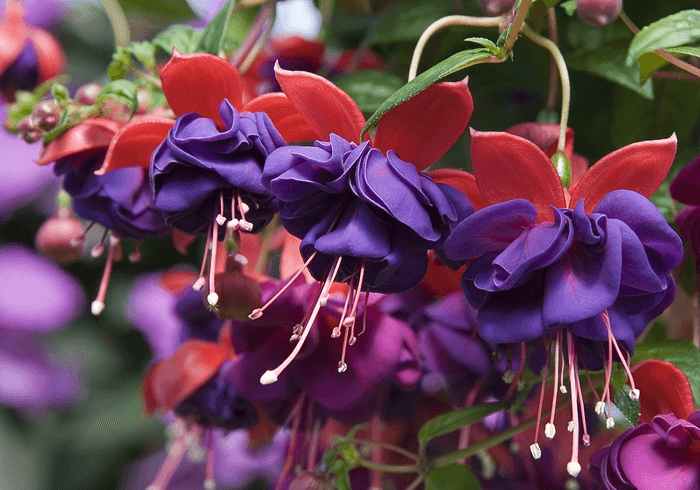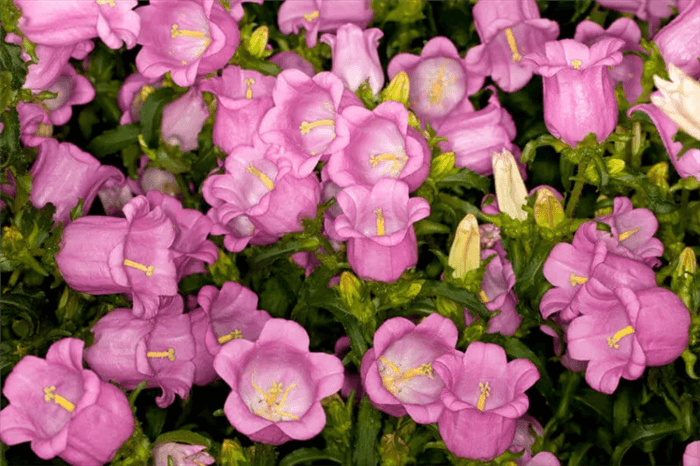The irresistible charm of lily of the valley is hard to match. This lovely groundcover woos us with its elusive scent and scallop-edged, bell-shaped blooms dangling above emerald foliage. Though tough to beat, several plants mimic the delicate beauty of lily of the valley.
We love how beautiful this classic perennial is at Gardenia Inc. But lily of the valley is a problem in some places because it spreads too quickly. Read on to learn about some beautiful alternatives to lily of the valley that have the same beauty without being as invasive.
An Overview of Lily of the Valley
The lily of the valley plant, whose botanical name is Convallaria majalis, is in the asparagus family. This plant is native to Eurasia and does best in shady spots. Its common name comes from the Latin words for valley and may flower, Vallis Majalis.
In spring, dainty yet intensely fragrant blooms line the stems for weeks. Bright red berries follow in fall. Despite a petite stature, barely reaching 10 inches, lily of the valley spreads stubbornly. It frequently becomes invasive, colonizing vast swaths of forest.
Numerous cultivars exist, including:
- ‘Rosea’ – Rosy pink blooms
- ‘Flore Pleno’ – Larger double-bell flowers
- ‘Fortin’s Giant’ – Outsized blooms
- ‘Hardwick Hall’ – Vigorous grower with yellow-chartreuse edged leaves
- ‘Albostriata’ – Open habit, white-streaked leaves
- ‘Albomarginata’ – Dark foliage edged in white
- ‘Bordeaux’ – Grows up to 12 inches with bigger blooms
Next, let’s explore some stellar plants that mirror the loveliness of lily of the valley without the aggression.
1. Japanese Pieris
Japanese pieris (Pieris japonica) also called lily-of-the-valley shrub, lives up to its name with pendant clusters of bells resembling Convallaria. This broadleaf evergreen provides year-round appeal opening with reddish-bronze new growth that matures to glossy green.
In late winter, purplish buds become drooping creamy or pale pink blooms. Slow growing, it works nicely for hedges, foundation plantings, or shrub borders. Japanese pieris thrives in moist, organically rich soil in sun to part shade.
2. Snowdrops
Snowdrops (Galanthus nivalis) are happy signs of spring that can often be seen through the snow. As winter ends, these 10-inch bulbs bloom with beautiful bell-shaped flowers on stalks without leaves above gray-green foliage.
Once established, snowdrops lift spirits in late winter. They don’t need much care as long as they get full sun to partial shade and good drainage. Plant in masses, drifts, patios, rock gardens, or under trees.
3. Ladybells
Ladybells (Adenophora bulleyana) are perennials in the Campanula family, flaunting bell-shaped periwinkle blooms on spikes in late spring. Common ladybells reach 24-36 inches tall, while compact species like lilyleaf ladybells stay under 18 inches.
Ladybells thrive in full sun and moist, well-drained soil. Charming in cottage, prairie, or woodland gardens, their blooms draw butterflies.
4. Fetterbush
Fetterbush (Pieris floribunda) is prized for fragrant bell-shaped blooms dangling along arching branches. Ranging white to blush pink, the blooms perfume the air throughout spring into early summer.
At home in bogs and wetlands, fetterbush reaches 3-6 feet tall and wide. It needs consistent moisture and partial shade. Use it along ponds, streams, or in woodland or cottage gardens. Note that, like lily of the valley, fetterbush is toxic if ingested.
5. Twinflower
Twinflower (Linnaea borealis) gets its name from paired pink and white bell-like blooms on slender double stalks. Round paired leaves echo the twin theme. Highly fragrant, the blooms appear in summer and last about a week.
At 10 inches tall, twinflower spreads readily, making a lush evergreen groundcover. A native of northern forests, it adapts well to home gardens and looks fantastic massed in wildflower plantings.
6. Swamp Doghobble
Swamp doghobble (Eubotrys racemosa), also called swamp sweetbells, has a weeping effect from white bell-shaped blooms weighing down the branches. It thrives along wetlands, streams, and in swamps or woodlands.
Though preferring shade, swamp doghobble tolerates full sun with sufficient moisture. Use it in shrub borders, cottage gardens, or native plantings near water. As with lily of the valley, it is poisonous if ingested.
7. Spring Snowflake
Spring snowflake (Leucojum vernum) delivers nodding, bell-shaped blooms with white petals and yellow-tipped centres. Like lily of the valley, it reaches just 10 inches in height given consistent moisture and well-drained soil.
An easy grower, spring snowflake thrives in full sun to part shade. Plant in sweeps and drifts to mimic spring snowfall. It earns awards for its cheerful blooms on upright stems.
8. Peach-Leaved Bellflower
Peach-leaved bellflower (Campanula persicifolia) is a fast-growing perennial flaunting abundant blue, white, or lilac bells dancing atop vibrant foliage in summer. It reaches 2 feet tall and appreciates full sun to partial shade with reliably moist soil.
Give this long-blooming plant room to shine by planting in groups. It adds bold splashes of color to perennial borders, cottage gardens, and containers, attracting butterflies.
9. Solomon’s Seal
Variegated Solomon’s seal (Polygonatum odoratum ‘Variegatum’) brings graceful, arching stems adorned with pairs of dangling, bell-shaped white blooms. The leaves showcase dark green centers with crisp white margins.
This carefree perennial thrives in part to full shade, reaching just 1 foot in height. It naturalizes nicely to form a lush groundcover. Variegated Solomon’s seal pops beautifully against its foliage.
10. Canterbury Bells
Canterbury bells (Campanula medium) flaunt abundant, wide open bell-shaped blooms up to 3 inches across. Colours range from blue, pink, purple and white. Canterbury bells act like larger versions of lily of the valley.
These fast growing biennials or short lived perennials reach 3 feet tall. For best results, plant in full sun to part shade in rich, well-drained soil. Deadhead spent blooms to encourage more flowers.
11. Summer Snowflake
Summer snowflake (Leucojum aestivum) closely resembles its cousin the spring snowflake, bearing nodding, bell-shaped blossoms. However, summer snowflake grows significantly larger, reaching up to 24 inches in height.
Provide it with partial shade and moist soil for best results. Plant en masse for a spectacular display. Summer snowflake naturalizes easily.
Conclusion
While lily of the valley charms the spring garden, some attractive alternatives bloom in summer. Spanning ground covers, perennials, bulbs, and shrubs, these selections echo the elegance of Convallaria without its aggressive spreading habit.
We hope these ideas inspire you to try some fresh options with the graceful charm of lily of the valley. Let us know if you have a favorite Convallaria lookalike we should add to our list!

Blue Fuchsia (Fuchsia magellanica)
Blue Fuchsia is a captivating flowering plant known for its stunning, pendulous blooms that feature vibrant blue and purple hues. This hardy perennial plant comes from South America and has beautiful flowers all summer long. The flowers are small and tubular and hang gracefully from arching stems. The blossoms attract hummingbirds and pollinators, making them a favorite in wildlife gardens. Garden beds, borders, and hanging baskets are all great places for blue fuchsia because it does best in well-drained soil and some shade. Its lush green foliage provides a beautiful backdrop for the colorful flowers, enhancing the overall aesthetic of the garden. With its enchanting appearance and ability to flourish in cooler climates, Fuchsia magellanica is a beloved choice for gardeners seeking to add a touch of elegance and charm to their outdoor spaces.

Pink Bell Shaped Flowers
Pink Campanula, also called the white bellflower, is a pretty perennial plant with beautiful pink flowers that nod in the air that grow in groups on tall, thin stems. Blooming from late spring to early summer, this variety adds a soft, romantic touch to gardens, reaching heights of 2 to 4 feet. The bell-shaped flowers are not only visually appealing but also attract various pollinators, including bees and butterflies. Pink Campanula thrives in well-drained soil and prefers full sun to partial shade, making it adaptable to different garden conditions. Its strong stems make it a great choice for cut flower arrangements, so gardeners can enjoy its beauty both inside and outside. With its delightful blooms and graceful form, Pink Campanula is a beloved addition to any garden, bringing elegance and charm to flower beds and borders.

Lily of the Valley – how to grow/convallaria majalis/toxic/invasive plant
FAQ
What looks similar to Lily of the Valley?
However, wild garlic can be confused with lily of the valley (Convallaria majalis), a poisonous plant which contains substances that act on the muscles of the heart. People confuse the two plants because the leaves of the two species are very similar. Wild garlic (left) growing next to lily of the valley (right).
What is an alternative to Lily of the Valley?
Looking for a native alternative to Lily of the Valley? Choose shade-loving groundcovers like wild ginger, foamflower, or Canada mayflower. These plants offer beautiful foliage and spring blooms, support local wildlife, and won’t become invasive.
How to tell the difference between ramps and Lily of the Valley?
Smell is the best way to distinguish Ramps from any of it’s look a likes. When you rip or crush the leaves of ramps you will get a strong garlic odor. You will not get the same smell from Lily of the Valley or False Hellebore.
What is the difference between summer snowflakes and Lily of the Valley?
Summer snowflake and lily of the valley, while both boasting delicate, white, bell-shaped flowers, are distinct plants with different characteristics. Summer snowflake is a taller, stronger plant with flowers that nod and have green tips. It grows naturally well and can handle a wider range of soil and light conditions better.
